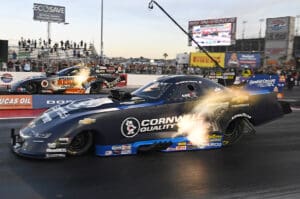 Rick Stewart, the former NHRA official starter for more than 15 years, passed away Friday in his home state of Texas following an extended illness.
Rick Stewart, the former NHRA official starter for more than 15 years, passed away Friday in his home state of Texas following an extended illness.
Nicknamed “The Ice Man,” Stewart was a fearless racer in the days of Top Fuel slingshot dragsters and subject of the 1965 documentary “7 Second Love Affair” before becoming only the second starter for the NHRA. Less than one month ago, March 10, he was inducted into the Don Garlits Museum of Drag Racing’s International Drag Racing Hall of Fame.
Stewart stepped into the hard-to-fill shoes of the legendary Buster Couch in 1996 and became a legend himself with his usually easygoing manner as he stood between the lanes and maintained order on the dragstrip for 15 years. He retired at the end of the 2011 season. “It was just an honor and pleasure to be the one to follow behind Buster Couch,” Stewart told Competition Plus in 2012.
“I really enjoyed drag racing (and) still do,” Stewart told Mike Griffith for a 2017 article in Bakersfield.com. “I got to meet so many people. It was a great experience.”
Stewart began attending the races at Famoso drag strip in the early 1950s. By 1963, he had teamed with Gene Adams and John Rasmussen to campaign a Woody Gilmore car that made for a very potent driver/tuner combination. Stewart retired from driving in 1971. He became a part-time starter for NHRA in 1995 and was hand-picked by the legendary Buster Couch as his replacement when he retired in 1996.
Writer Mike Bumbeck, in a November 2011 article in Hemmings magazine, said, “Rick was the focus of one of the best 52 minutes of drag racing documentary ever made. Written by Bob Abel, shot by Les Blank, and with a soundtrack from Canned Heat, 7 Second Love Affair followed Rick and crew around the drag strips of ’60s Southern California in a journey through the apex of SoCal top fuel drag racing. We spoke with Rick a few years back about the time and the movie, and he confirmed that drag racing was in fact the hot setup then.
“A typical weekend would be Friday night down at Carlsbad, Saturday night at Lions Drag Strip, Sunday from 11-3 p.m. at San Fernando, Sunday afternoon at Fontana. Eighty top fuel cars would show up to qualify for eight spots and $1,000 to win. We were just thrilled we were getting $25 or $50 a round,” the article said.
Bumbeck wrote that Stewart “retired from Top Fuel driving on the top end of the quarter-mile while testing some new tires in his hometown of Bakersfield, Calif. He quoted Stewart as saying, ‘I was smoking ’em down the dragstrip about the fourth of fifth run of that day. I pulled the parachute. We had set a track record for elapsed time and speed. When I pulled the parachute, there were three bars in the back, right behind me, the driver. Hooked to those three bars is some chromoly plate. Hooked to that plate are the seat belts and shoulder harnesses. The plate broke loose. Me and the aluminum seat went underneath the roll booth. Just me and the aluminum seat and the parachute. I went from about 200 miles per hour to zero in about 300 feet, and I walked away. I said ‘That’s it. ‘Bye!’”
After that, Stewart preferred the bone-shaking, ear-splitting position between two race cars at the starting line. He regarded it as the best seat in the house.
Mark Lyle replaced Stewart, and when Lyle passed away unexpectedly in March 2016, Mike Gittings stepped into the role.
Gittings said Friday, “When I met him in Texas, he said, ‘It’s a 2×4 reunion.’ That – ‘2×4’ – refers to No. 2 Chief Starter and No. 4. I watched them all: Buster, Rick and, of course Mark [his mentor],” and we always worked together. He loved drag racing and being a chief starter.”






































